Personnel Costs and Labour Productivity: The Case of European Manufacturing Industry
Abstract
1. Introduction
2. Literature Review
3. Methodology
- indicators related to productivity:
- ○
- apparent labour productivity (gross value added per person employed)—thousand euros (ALP);
- ○
- wage-adjusted labour productivity (apparent labour productivity by average personnel costs)—percentage (WALP);
- ○
- turnover per person employed—thousand euros (TPE);
- indicators related to personnel costs:
- ○
- average personnel costs (personnel costs per person employed)—thousand euros (AC);
- ○
- employer’s social charges as a percentage of personnel costs—percentage (CH);
- ○
- share of personnel costs in production—percentage (CPR);
- ○
- share of personnel costs in gross value added—percentage (CGVA);
- ○
- of wages and salaries in gross value added—percentage (WGVA);
- ○
- share of social security costs in gross value added—percentage (SSGVA);
- other indicators related to the industry or macroeconomics:
- ○
- persons employed—number (PE),
- ○
- enterprises—number (EN),
- ○
- persons employed per enterprise—number (PEE),
- ○
- gross operating rate—percentage (GOR),
- ○
- price level indices, EU15 = 100 (PL),
- ○
- gross domestic product at market prices, current prices, euro per capita (GDP).
- the independent samples t-test is used to distinguish indicators that differ significantly between countries with higher apparent labour productivity and countries with lower apparent labour productivity;
- unit root test is employed to define the order of integration of a time series;
- correlation analysis is used to show how strong the relationship between apparent labour productivity and other indicators under investigation is;
- the Granger causality test is used to define the delayed effect (lags) and the direction of the relationship between apparent labour productivity and other indicators under investigation;
- cointegration analysis is used to examine if there is a long run equilibrium relationship between ALP and AC or other indicators. The autoregressive distributed lag (ARDL) cointegration technique (ARDL bounds testing) developed by Pesaran et al. (2001) is adopted. The advantage of this model is that it can be used in time series that are not integrated in the same order (i.e., mixture of I(0) or i(1), but not I(2)). It also allows the series to have different optimal lags. ARDL test estimates of the following unrestricted error correction model:here yt and , i = 1, …, p, are differenced apparent labour productivity at time t and t − i respectively, is apparent labour productivity at time t − 1, , j = 1, …, q, are differenced average personnel costs at time t − j, is average personnel costs at time t − 1, p and q are numbers of lags of apparent labour productivity and average personnel costs, respectively, , , , , and are parameters, and is an error term.
4. Results and Discussion
5. Conclusions
Author Contributions
Funding
Institutional Review Board Statement
Informed Consent Statement
Data Availability Statement
Conflicts of Interest
References
- Alexander, Carol. 1993. The changing relationship between productivity, wages and unemployment in the UK. Oxford Bulletin of Economics and Statistics 55: 87–102. [Google Scholar] [CrossRef]
- Banker, Rajiv D., Danlu Bu, and Mihir N. Mehta. 2016. Pay gap and performance in China. Abacus 52: 501–31. [Google Scholar] [CrossRef]
- Bassanini, Andrea, and Danielle Venn. 2008. The Impact of Labour Market Policies on Productivity in OECD Countries. International Productivity Monitor, Centre for the Study of Living Standards 17: 3–15. [Google Scholar]
- Bildirici, Melike, and Elcin A. Alp. 2008. The relationship between wages and productivity: TAR unit root and TAR cointegration approach. International Journal of Applied Econometrics and Quantitative Studies 5: 93–110. [Google Scholar]
- Black, Sandra, and Lisa Lynch. 2002. How to Compete: The Impact of Workplace Practices and Information Technology on Productivity. Review of Economics and Statistics 83: 434–45. [Google Scholar] [CrossRef]
- Blanchard, Olivier. 2006. European unemployment: The evolution of facts and ideas. Economic Policy 21: 5–59. [Google Scholar] [CrossRef]
- Cirillo, Valeria, and Andrea Ricci. 2020. Heterogeneity matters: Temporary employment, productivity and wages in Italian firms. Economia Politica. [Google Scholar] [CrossRef]
- Corrado, Carol, Jonathan Haskel, Cecilia J. Lasinio, and Massimiliano Iommi. 2014. Intangibles and Industry Productivity Growth: Evidence from the EU. Paper presented at IARIW 33rd General Conference, Rotterdam, The Netherlands, August 24–30. [Google Scholar]
- Dai, Yunhao, Dongmin Kong, and Jin Xu. 2017. Does fairness breed efficiency? Pay gap and firm productivity in China. International Review of Economics & Finance 48: 406–22. [Google Scholar] [CrossRef]
- Dosi, Giovanni, Dario Guarascio, Andrea Ricci, and Maria E. Virgillito. 2019. Neodualism in the Italian business firms: Training, organizational capabilities, and productivity distributions. Small Business Economics 57: 167–89. [Google Scholar] [CrossRef]
- Dunlop, John T. 1985. Industrial relations and economics: The common frontier of wage determination. In Industrial Relations Research Association, Proceedings of the Thirty-Seventh Annual Winter Meeting, 9–23. Madison: IRRA. [Google Scholar]
- Erenburg, Sharon J. 1998. Productivity, private and public capital and real wage in the US. Applied Economics Letters 5: 491–95. [Google Scholar] [CrossRef]
- Eurostat. 2021. Available online: https://ec.europa.eu/eurostat/data/database (accessed on 2 June 2021).
- EViews. 2021. Available online: https://www.eviews.com/general/about_us.html (accessed on 2 February 2021).
- Faleye, Olubunmi, Ebru Reis, and Anand Venkateswaran. 2013. The determinants and effects of CEO–employee pay ratios. Journal of Banking Finance 37: 3258–72. [Google Scholar] [CrossRef]
- Feldstein, Martin S. 2008. Did wages reflect growth in productivity? Journal of Policy Modelling 30: 591–94. [Google Scholar] [CrossRef]
- Hellebrandt, Tomas, Michael Jarand, Jacob F. Kirkegaard, Tyler Moran, Adam S. Posen, Justin Wolfers, and Jan Zilinsky. 2015. Raising Lower-Level Wages—When and Why It Makes Economic Sense. PIIE Briefing 15-2. Washington, DC: Peterson Institute for International Economics. [Google Scholar]
- Herman, Emilia. 2020. Labour Productivity and Wages in the Romanian Manufacturing Sector. Procedia Manufacturing 46: 313–21. [Google Scholar] [CrossRef]
- Kampelmann, Stephan, Francois Rycx, Yves Saks, and Ilan Tojerow. 2018. Does education raise productivity and wages equally? The moderating role of age and gender. IZA Journal of Labor Economics 7: 1–37. [Google Scholar] [CrossRef]
- Katz, Lawrence F. 1986. Efficiency Wage Theories: A Partial Evaluation. In NBER Macroeconomics Annual. Cambridge: MIT Press, vol. 1, pp. 235–90. [Google Scholar]
- Kleinknecht, Alfred. 2020. The (negative) impact of supply-side labour market reforms on productivity: An overview of the evidence. Cambridge Journal of Economics 44: 445–64. [Google Scholar] [CrossRef]
- Kumar, Saten, Don J. Webber, and Geoff Perry. 2012. Real wages, inflation and labor productivity in Australia. Applied Economics 44: 2945–54. [Google Scholar] [CrossRef][Green Version]
- Lawrence, Robert Z. 2016. Does productivity still determine worker compensation? Domestic and international evidence. In The US Labour Market: Questions and Challenges for Public Policy. Washington, DC: American Enterprise Institute Press. [Google Scholar]
- Leibenstein, Harvey. 1957. The Theory of Underdevelopment in Densely Populated backward areas. In Economic Backwardness and Economic Growth. Edited by Leibenstein Harvey. New York: Wiley. [Google Scholar]
- Liu, Jeng. 2002. Does Wage Inequality Affect Labor Productivity? Some Evidence from Manufacturing Industries of Taiwan and South Korea. Asian Pacific Management Review 7: 449–76. [Google Scholar]
- Lopez-Villavicencio, Antonia, and Jose I. Silva. 2011. Employment protection and the non-linear relationship between the wage-productivity gap and unemployment. Scottish Journal of Political Economy 58: 200–20. [Google Scholar] [CrossRef]
- Meager, Nigel, and Stefan Speckesser. 2011. Wages, Productivity and Employment: A Review of Theory and International Data. Birmingham: EEO Thematic Report, European Employment Observatory. [Google Scholar]
- Mora, Toni, Jordi Lopez-Tamayo, and Jordi Surinach. 2005. Are wages and productivity converging simultaneously in euro area countries? Applied Economics 37: 2001–8. [Google Scholar] [CrossRef]
- Pesaran, M. Hashem, Yongcheol Shin, and Richard J. Smith. 2001. Bounds testing approaches to the analysis of level relationship. Journal of Applied Economics 16: 289–326. [Google Scholar] [CrossRef]
- Piper, Denise, Fernando Ferrari-Filho, and Marcos T. Lelis. 2020. The Relationship between Productivity and Inflation: An Empirical Analysis of the Brazilian Economy. Theoretical Economics Letters 10: 563–78. [Google Scholar] [CrossRef]
- Policardo, Laura, Lionello F. Punzo, and Edgar J. Sanchez Carrera. 2019. On the wage–productivity causal relationship. Empirical Economics 57: 329–43. [Google Scholar] [CrossRef]
- Reynolds, Lloyd G. 1978. Labor Economics and Labor Relations, 7th ed. Englewood Cliffs: Prentice-Hall. [Google Scholar]
- Romer, David. 2018. Advanced Macroeconomics, 5th ed. New York: McGraw-Hill Irwin. [Google Scholar]
- Sharpe, Andrew, Jean F. Arsenault, and Peter Harrison. 2008. The Relationship between Labour Productivity and Real Wage Growth in Canada and OECD Countries. CSLS Research Report No. 2008-8. Ottawa: CSLS. [Google Scholar]
- Solow, Robert M. 1979. Another possible source of wage stickiness. Journal of Macroeconomics 1: 79–82. [Google Scholar] [CrossRef]
- Stansbury, Anna, and Lawrence H. Summers. 2018. Productivity and Pay: Is the Link Broken? PIIE Working Paper 18-5. Washington, DC: PIIE. [Google Scholar]
- Storm, Servaas, and Ro C. W. M. Naastepad. 2007. Why Labor Market Regulation May Pay Off: Worker Motivation, Coordination and Productivity Growth. Economic and Labor Market Paper, 2007/4. Geneve: International Labour Organization. [Google Scholar]
- Tang, Chor F. 2014. The effect of real wages and inflation on labor productivity in Malaysia. International Review of Applied Economics 28: 311–22. [Google Scholar] [CrossRef]
- Wakeford, Jeremy. 2004. The productivity-wage relationship in South Africa: An empirical investigation. Development Southern Africa 21: 109–32. [Google Scholar] [CrossRef]
- Yildirim, Zekeriya. 2015. Relationships among labour productivity, real wages and inflation in Turkey. Economic Research-Ekonomska Istraživanja 28: 85–103. [Google Scholar] [CrossRef]
- Yusof, Selamah A. 2008. The long-run and dynamic behaviors of wages, productivity and employment in Malaysia. Journal of Economic Studies 35: 249–62. [Google Scholar] [CrossRef]
- Zhang, Jun, and Xiaofeng Liu. 2013. The evolving pattern of the wage–labor productivity nexus in China: Evidence from manufacturing firm-level data. Economic Systems 37: 354–68. [Google Scholar] [CrossRef]
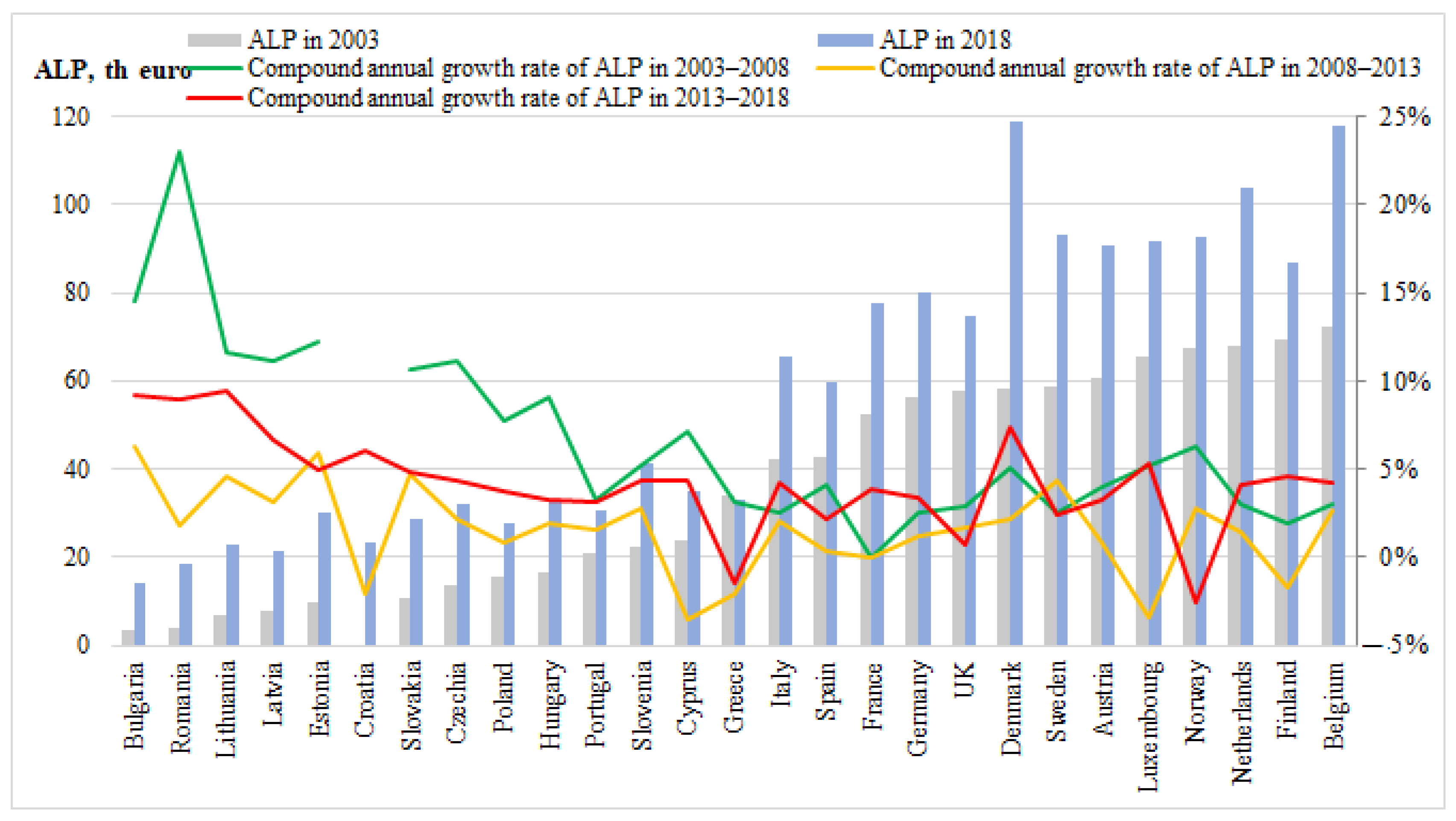
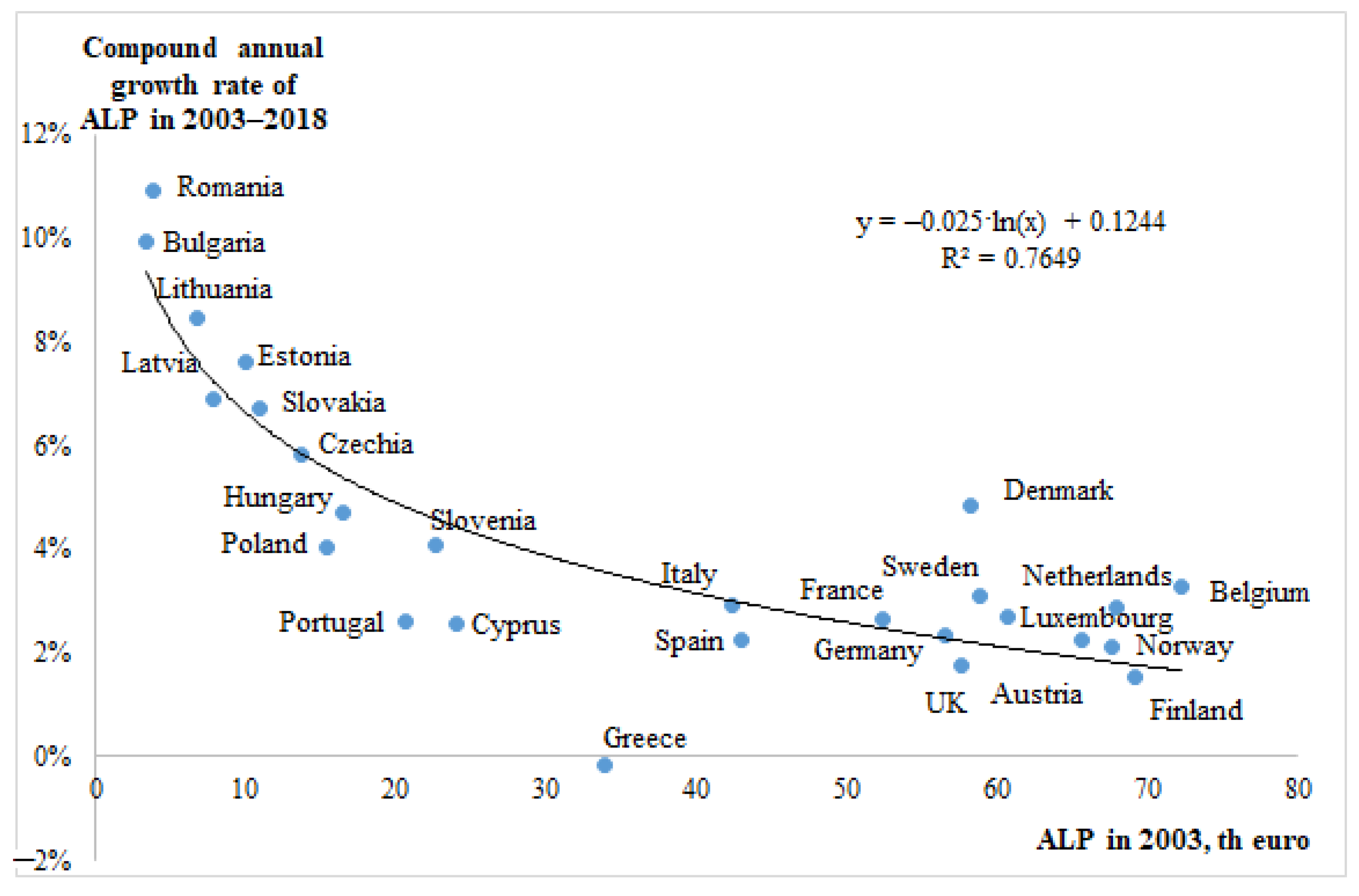
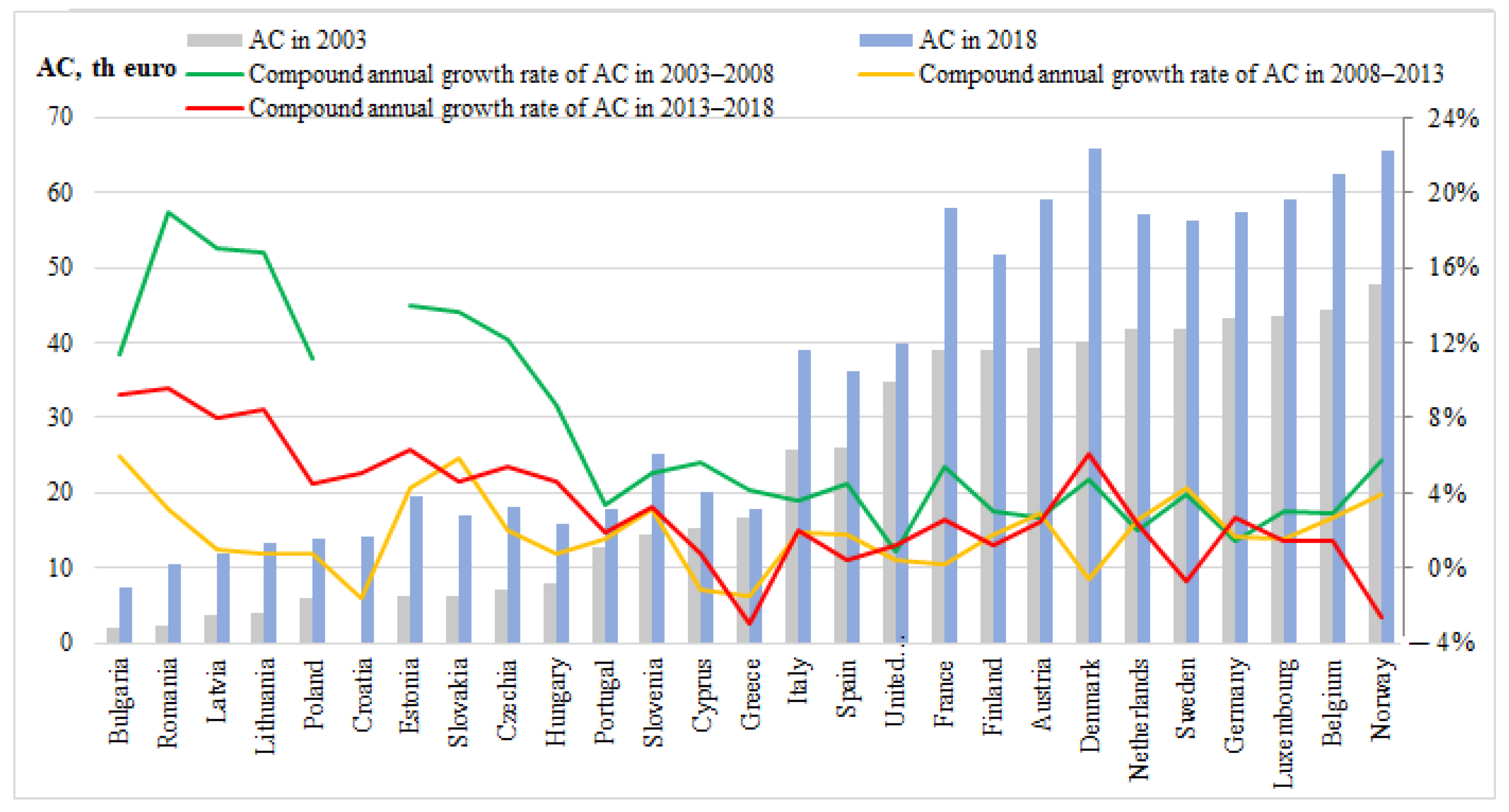
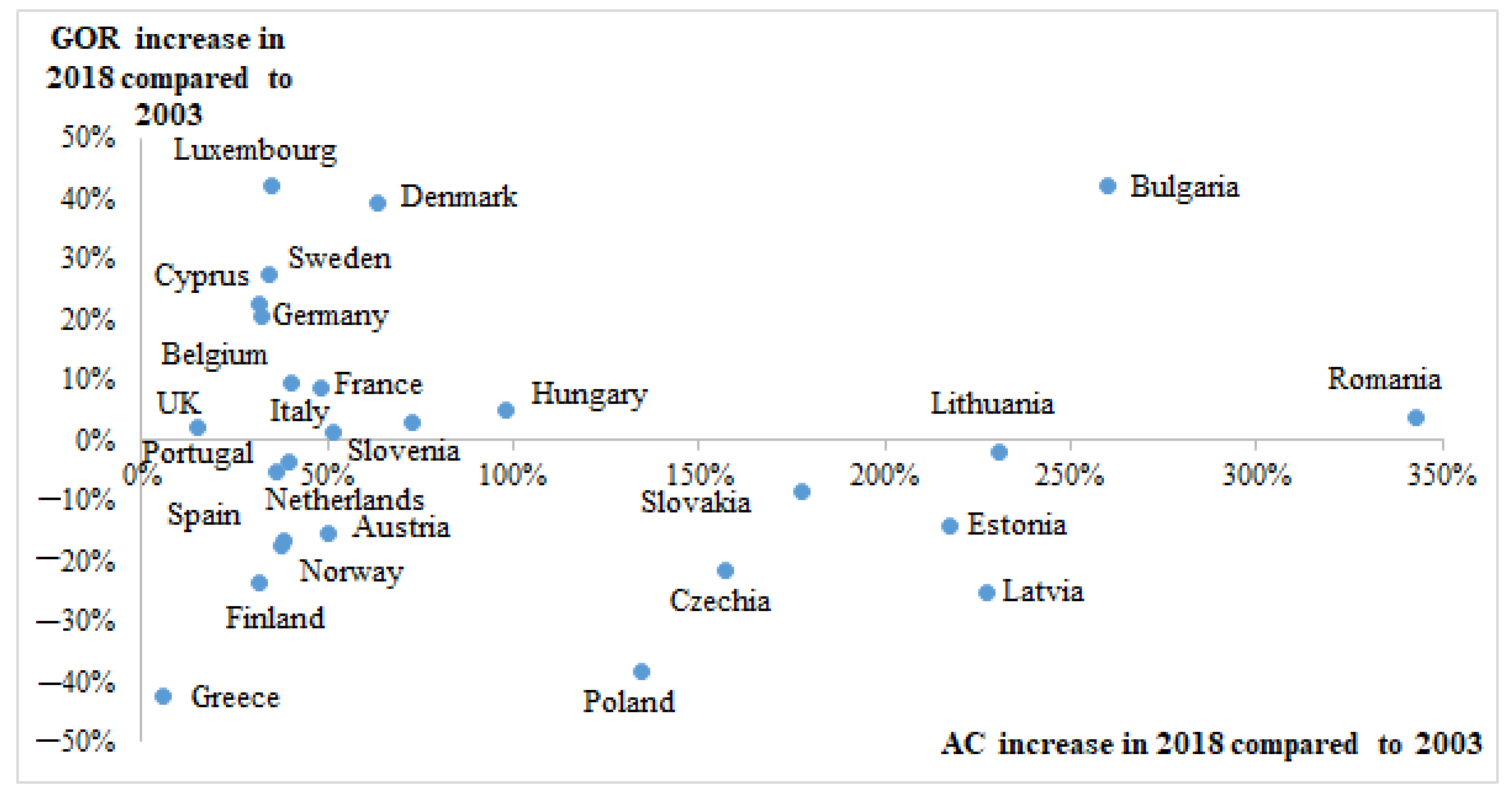
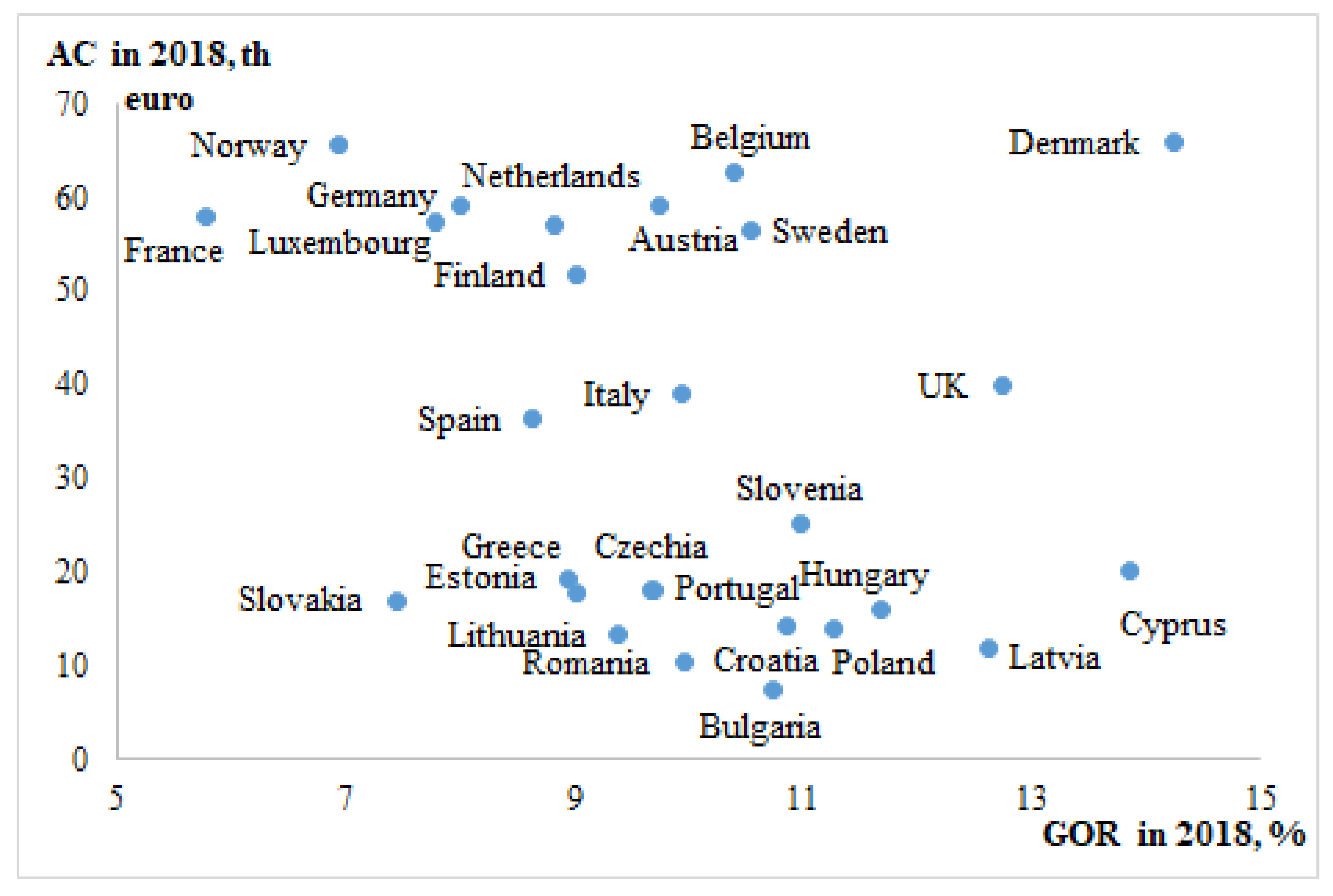
| Independent Variables | Coefficient | Std. Error | p-Value |
|---|---|---|---|
| C | 0.3946 | 0.2566 | 0.1249 |
| ∆ALP(−1) | −0.0699 | 0.0387 | 0.0718 |
| ∆ALP(−2) | −0.1486 | 0.0380 | 0.0001 |
| ∆AC | 1.3101 | 0.0811 | 0.0000 |
| ALP(−1) | −0.0580 | 0.0244 | 0.0178 |
| AC(−1) | 0.1032 | 0.0359 | 0.0042 |
| Adjusted R-squared | 0.5848 | ||
| p-value of Pesaran CD | 0.3136 | ||
| H0: all θi = 0 jointly p-value | F-statistic | Chi-square | |
| 0.0016 | 0.0015 | ||
| Long-run multiplier of AC | 1.7776 | ||
| Indicator | Countries with ALP Lower (1) or Higher (2) than the Average | Group Statistics | Equal Variances Assumed (A)/Not Assumed (NA) | Levene’s Test for Equality of Variances | t-Test for Equality of Means | ||||
|---|---|---|---|---|---|---|---|---|---|
| N | Mean | Std. Dev. | F | Sig. | t | Sig. (2-Tailed) | |||
| ALP | 1 | 280 | 22.65 | 10.96 | A | 28.70 | 0.000 | −41.82 | 0.000 |
| 2 | 267 | 70.48 | 15.50 | NA | −41.49 | 0.000 | |||
| WALP | 1 | 276 | 167.86 | 24.18 | A | 30.49 | 0.000 | 9.89 | 0.000 |
| 2 | 267 | 150.35 | 16.15 | NA | 9.95 | 0.000 | |||
| TPE | 1 | 280 | 94.19 | 43.54 | A | 94.54 | 0.000 | −29.88 | 0.000 |
| 2 | 267 | 285.83 | 97.63 | NA | −29.41 | 0.000 | |||
| AC | 1 | 324 | 13.12 | 8.66 | A | 8.80 | 0.003 | −44.40 | 0.000 |
| 2 | 267 | 47.07 | 9.92 | NA | −43.82 | 0.000 | |||
| CH | 1 | 323 | 21.62 | 5.82 | A | 12.16 | 0.001 | 1.70 | 0.090 |
| 2 | 266 | 20.73 | 6.90 | NA | 1.67 | 0.095 | |||
| CPR | 1 | 329 | 15.19 | 3.68 | A | 9.86 | 0.002 | −10.91 | 0.000 |
| 2 | 267 | 18.30 | 3.17 | NA | −11.08 | 0.000 | |||
| CGVA | 1 | 285 | 0.57 | 0.08 | A | 3.12 | 0.078 | −11.77 | 0.000 |
| 2 | 267 | 0.64 | 0.07 | NA | −11.84 | 0.000 | |||
| WGVA | 1 | 282 | 0.45 | 0.07 | A | 0.09 | 0.761 | −10.26 | 0.000 |
| 2 | 266 | 0.51 | 0.07 | NA | −10.28 | 0.000 | |||
| SSGVA | 1 | 282 | 0.12 | 0.04 | A | 17.85 | 0.000 | −3.27 | 0.001 |
| 2 | 266 | 0.13 | 0.05 | NA | −3.25 | 0.001 | |||
| GOR | 1 | 279 | 10.40 | 2.52 | A | 3.87 | 0.050 | 5.65 | 0.000 |
| 2 | 267 | 9.20 | 2.47 | NA | 5.65 | 0.000 | |||
| EN | 1 | 333 | 77,276.16 | 110,557.56 | A | 4.86 | 0.028 | −1.73 | 0.084 |
| 2 | 263 | 92,842.19 | 106,857.11 | NA | −1.74 | 0.083 | |||
| PE | 1 | 312 | 933,999.82 | 1,103,793.57 | A | 89.69 | 0.000 | −5.42 | 0.000 |
| 2 | 267 | 1,655,737.49 | 2,027,583.93 | NA | −5.19 | 0.000 | |||
| PEE | 1 | 308 | 16.94 | 12.40 | A | 5.52 | 0.019 | −3.83 | 0.000 |
| 2 | 263 | 20.46 | 8.98 | NA | −3.92 | 0.000 | |||
| GDP | 1 | 374 | 12,023.48 | 6,940.51 | A | 65.30 | 0.000 | −29.02 | 0.000 |
| 2 | 267 | 37,935.96 | 15,195.13 | NA | −26.00 | 0.000 | |||
| PL | 1 | 329 | 78.57 | 14.31 | A | 0.03 | 0.873 | −25.39 | 0.000 |
| 2 | 267 | 107.55 | 13.28 | NA | −25.59 | 0.000 | |||
| ALP_PL | 1 | 280 | 27.99 | 11.15 | A | 5.36 | 0.021 | −35.16 | 0.000 |
| 2 | 267 | 65.92 | 13.98 | NA | −34.97 | 0.000 | |||
| TPE_PL | 1 | 280 | 117.37 | 47.09 | A | 47.53 | 0.000 | −23.14 | 0.000 |
| 2 | 267 | 269.41 | 98.83 | NA | −22.79 | 0.000 | |||
| AC_PL | 1 | 295 | 17.11 | 8.40 | A | 0.47 | 0.493 | −38.12 | 0.000 |
| 2 | 267 | 43.92 | 8.24 | NA | −38.16 | 0.000 | |||
| H: **** | Granger Causality Test When | r | ||
|---|---|---|---|---|
| l = 1 | l = 2 | l = 3 | ||
| ∆WALP → ∆ALP ∆ALP → ∆WALP | 0.3852 0.0337 | 0.1756 0.0021 | 0.4126 0.0001 | 0.4683 *** |
| ∆AC → ∆ALP ∆ALP → ∆AC | 0.0988 0.3414 | 0.0185 0.7779 | 0.0939 0.8748 | 0.6018 *** |
| ∆CH → ∆ALP ∆ALP → ∆CH | 0.8024 0.0272 | 0.9229 0.0222 | 0.4981 0.0181 | −0.0129 |
| ∆CPR → ∆ALP ∆ALP → ∆CPR | 0.0051 0.9900 | 0.0041 0.0000 | 0.0012 0.0000 | −0.3170 *** |
| ∆CGVA → ∆ALP ∆ALP → ∆CGVA | 0.1559 0.0291 | 0.0486 0.0003 | 0.1604 0.0012 | −0.5534 *** |
| ∆WGVA → ∆ALP ∆ALP → ∆WGVA | 0.0768 0.1015 | 0.0284 0.0130 | 0.1318 0.0106 | −0.6164*** |
| ∆SSGVA → ∆ALP ∆ALP → ∆SSGVA | 0.7897 0.0002 | 0.3142 0.0000 | 0.3790 0.0001 | −0.2672 *** |
| ∆GOR → ∆ALP ∆ALP → ∆GOR | 0.1211 0.9587 | 0.0694 0.0016 | 0.3251 0.0001 | 0.4588 *** |
| ∆PE → ∆ALP ∆ALP → ∆PE | 0.2634 0.3031 | 0.3841 0.1503 | 0.1509 0.3123 | 0.0970 ** |
| ∆PEE → ∆ALP ∆ALP → ∆PEE | 0.1337 0.0230 | 0.6224 0.0693 | 0.5387 0.1529 | −0.0324 |
| ∆EN → ∆ALP ∆ALP → ∆EN | 0.1859 0.9813 | 0.2597 0.4665 | 0.2428 0.4731 | 0.0762 * |
| ∆PL → ∆ALP ∆ALP → ∆PL | 0.9699 0.9368 | 0.7594 0.6465 | 0.9712 0.7501 | 0.2357 *** |
| ∆GDP → ∆ALP ∆ALP → ∆GDP | 0.2521 0.7236 | 0.2635 0.0100 | 0.0363 0.0088 | 0.6125 *** |
| ∆ALP → ∆TPE∆TPE → ∆ALP | 0.0000 0.0000 | 0.0001 0.0000 | 0.0001 0.0001 | 0.5203 *** |
| ∆AC → ∆TPE ∆TPE → ∆AC | 0.3408 0.1400 | 0.2202 0.3317 | 0.4171 0.5912 | 0.3029 *** |
| Predicted Indicator | The Expected Increase in GOR | Growth of AC | |
|---|---|---|---|
| Assumptions | AC Increases by 1 Thousand Euro TPE Is Const. PE Is Const. | TPE Increases by 1 Thousand Euro GOR Is Const. PE Is Const. | |
| Country | |||
| Belgium | 0.56% | −0.11% | |
| Bulgaria | 4.58% | −1.00% | |
| Czechia | 2.24% | −0.35% | |
| Denmark | 0.59% | −0.17% | |
| Germany | 1.37% | −0.08% | |
| Estonia | 2.89% | −0.29% | |
| Greece | 2.03% | −0.32% | |
| Spain | 1.32% | −0.14% | |
| France | 1.59% | −0.04% | |
| Croatia | 3.39% | −0.53% | |
| Italy | 1.18% | −0.17% | |
| Cyprus | 2.05% | −0.52% | |
| Latvia | 3.21% | −0.78% | |
| Lithuania | 3.26% | −0.46% | |
| Luxembourg | 0.95% | −0.08% | |
| Hungary | 1.83% | −0.52% | |
| Netherlands | 0.66% | −0.10% | |
| Austria | 0.98% | −0.11% | |
| Poland | 2.22% | −0.57% | |
| Portugal | 2.47% | −0.35% | |
| Romania | 3.89% | −0.63% | |
| Slovenia | 1.93% | −0.30% | |
| Slovakia | 2.61% | −0.24% | |
| Finland | 0.88% | −0.11% | |
| Sweden | 0.84% | −0.13% | |
| United Kingdom | 0.89% | −0.23% | |
| Norway | 1.15% | −0.05% | |
| Independent Variables | Coefficient | Std. Error | p-Value |
|---|---|---|---|
| C | 0.1782 | 0.2487 | 0.4741 |
| ∆ALP(−1) | −0.0584 | 0.0438 | 0.1830 |
| ∆ALP(−2) | −0.0577 | 0.0373 | 0.1226 |
| ∆ALP(−3) | 0.1117 | 0.0393 | 0.0047 |
| ∆AC | 1.1797 | 0.0781 | 0.0000 |
| ∆TPE | 0.0337 | 0.0049 | 0.0000 |
| ∆TPE(−1) | 0.0279 | 0.0053 | 0.0000 |
| ALP(−1) | −0.0854 | 0.0263 | 0.0013 |
| AC(−1) | 0.1011 | 0.0342 | 0.0033 |
| TPE(−1) | 0.0048 | 0.0027 | 0.0701 |
| Adjusted R-squared | 0.6703 | ||
| p-value of Pesaran CD | 0.5535 | ||
| H0: all θi = 0 jointly p-value | F-statistic | Chi-square | |
| 0.0083 | 0.0077 | ||
| Long-run multiplier of | |||
| AC | 1.1836 | ||
| TPE | 0.0565 | ||
Publisher’s Note: MDPI stays neutral with regard to jurisdictional claims in published maps and institutional affiliations. |
© 2022 by the authors. Licensee MDPI, Basel, Switzerland. This article is an open access article distributed under the terms and conditions of the Creative Commons Attribution (CC BY) license (https://creativecommons.org/licenses/by/4.0/).
Share and Cite
Stundziene, A.; Baliute, A. Personnel Costs and Labour Productivity: The Case of European Manufacturing Industry. Economies 2022, 10, 31. https://doi.org/10.3390/economies10020031
Stundziene A, Baliute A. Personnel Costs and Labour Productivity: The Case of European Manufacturing Industry. Economies. 2022; 10(2):31. https://doi.org/10.3390/economies10020031
Chicago/Turabian StyleStundziene, Alina, and Asta Baliute. 2022. "Personnel Costs and Labour Productivity: The Case of European Manufacturing Industry" Economies 10, no. 2: 31. https://doi.org/10.3390/economies10020031
APA StyleStundziene, A., & Baliute, A. (2022). Personnel Costs and Labour Productivity: The Case of European Manufacturing Industry. Economies, 10(2), 31. https://doi.org/10.3390/economies10020031





